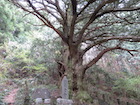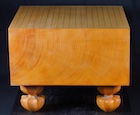Torreya nucifera
(L.) Siebold et Zuccarini 1846
Common names
榧, カヤ, Kaya [Japanese]; 비자나무 bija [Korean], Japanese nutmeg.
Taxonomic notes
Synonymy (Farjon 1998):
- Taxus nucifera Linnaeus;
- Podocarpus nucifer Loudon;
- Caryotaxus nucifera (L.) Henkel et W. Hochst. 1865;
- Foetataxus nucifera (L.) Nelson;
- Tumion nuciferum (L.) Greene;
- T. ascendens Nakai ex Uyeki;
- T. fruticosa Nakai;
- T. igaensis Doi et Morikawa;
- T. macrosperma Miyoshi;
- T. nucifera var. articulata Miyoshi;
- T. nucifera var. radicans Nakai;
- T. unda Miyoshi.
Several varieties have been described, and although they are not recognized here (pending further information on intraspecific variation in the species), they are briefly noted below.
Description
Dioecious evergreen trees to 25 m tall and 200 cm dbh, with a broad crown of wide-spreading branches. Bark smooth, roughened or sometimes flaky, developing irregular longitudinal fissures, pale yellow-brown, aging to dark gray. Twigs slender, round, usually with opposite branching, sometimes with more than two laterals from a node, spreading horizontally at 40-80° from the main twig, yellow-green turning reddish or purplish brown after a year, grooved along decurrent leaf bases. Buds terminal and very small, or at previous year's node and enlarged, broad-triangular, keeled, brown, deciduous. Leaves pectinate, spreading at 75-90° from the shoot, linear, 20-35 × 2.2-3.5 mm, straight or slightly downturned, with a twisted short petiole, abruptly wider at base, apex cuspidate or spinose, coriaceous, lustrous dark green above, with two stomatal bands on lower surface, 0.3-0.4 mm wide, separated by a midrib and bordered by 0.7-1 mm wide flat and slightly raised margins; stomata randomly distributed within the band. Pollen cones axillary, solitary, in short rows below lateral twigs, 5-7 × 4-5 mm, pale yellow at maturity. Seeds borne in axillary structures, solitary or paired, sessile, the ripe aril fleshy, smooth, dark green with longitudinal purple-brown striations near apex, variably ovoid, 20-30 × 13-18 mm (Farjon 2010).
Ohwi (1965) recognizes a number of varieties, which are not mentioned by Farjon (2010). Var. radicans is shrubby, native to the Honshu mountains. Var. macrosperma has a large seed 35-40 mm long, and is found only in the Mie and Shiga prefectures on Honshu. Var. igaensis has shorter (10-18 mm long), abruptly spinescent leaves, with a short (20 mm) seed. It is rare, found only in Iga Prefecture on Honshu.
Distribution and Ecology
Japan: South Honshu, Kyushu, and Shikoku; South Korea: Jeju Island and Wando Island (Hsu 2019), typically in mixed forest that may include Chamaecyparis obtusa, Podocarpus macrophyllus, Nageia nagi, Taxus cuspidata and Sciadopitys verticillata (Farjon 2010). On Jeju Island, home to the oldest known T. nucifera forest, soils are of volcanic derivation and average temperatures range from 5.3°C in January to 26.7°C in August (mean annual temperature, 15.7°C), and average annual precipitation is 1774 mm, with a maximum of 308 mm in August (Hsu 2019, citing meteorological data). Hardy to Zone 7 (cold hardiness limit between -17.7°C and -12.2°C) (Bannister and Neuner 2001).
Remarkable Specimens
The largest specimens are associated with shrines and temples in Japan. As a courtesy they are claimed to be over 1,000 years old, though there seem to be no data. The largest include (Hsu 2019):
- The Kaya at Yokomuro, Gunma Prefecture. Designated as a national Natural Monument, the tree is
24 m tall with a girth of 8.1 m (at an unspecified height).
- The Kaya at Yono City, Saitama Prefecture, is 22 m tall with a girth of 7.6 m (at an unspecified height). This is the upper tree shown at right.
- The Great Kaya of Mansho-ji, Kuwaori Town, Fukushima Prefecture is 15 m tall with a girth of 8.7 m (at an unspecified height).
See also the "Giant Kaya Tree List" for numbers and photos of some truly spectacular Japanese trees.
In North America, a tree in the Morris Arboretum, Pennsylvania, is 21 m tall with a dbh of 114 cm and a crown spread of 15 m. There are also two large trees in the New York Botanical Garden, one reportedly 15 m tall and 137 cm dbh, the other 11 m tall and 357 cm dbh; I strongly suspect that is actually a girth measurement (Hsu 2019).
In Europe, the largest specimen appears to be at the Ricasoli Garden in Udine, Italy; planted in about 1810, in 2016 it had a girth of 334 cm (106 cm dbh) and a height of 20.0 m (Monumental Trees 2019).
Historically, Wilson (1916) provides a photo of a tree that appears to be at least 2 m in diameter. This may be what he describes as "the largest tree of Torreya nucifera I saw in Japan," a specimen "28 m. in height and has a slightly buttressed trunk which measures 5.5 m. in girth at 1.6 m. from the ground;" it was (is?) at Hachiman Shrine, Kamo, in Satsuma province, Kyushu, and was but one of several very large specimens. I believe this tree is located at about 31.766°N, 130.571°E.
Ethnobotany
T. nucifera has a role in Japan quite similar to that of T. grandis in China. The Japanese value the seeds as a food source, roasting them for food and also extracting their oil. The oil is rich in Vitamin E and sciadonic acid, an omega-6 fatty acid (Kaya-no-Mori 2019, cited by Hsu 2019). In Akadomari, in the south of Sado Island, the seeds flavor deep-fried snacks unique to that region. The wood is very valuable, its rich yellow color revered for making Go boards, which has led to severe depletion of wild trees. Currently logging is prohibited, barring only removal of trees that have died from natural causes. Kurokigoishiten Co. Ltd. (2019), a Japanese company that makes Go boards, considers the best trees for wood to be in the Miyazaki region, Kyushu Island, because it has a climate conducive to consistently even and beautiful grain patterns. The wood must be between 200 and 800 years old to be suited for making a Go board (Hsu 2019). In view of this, fine modern Go boards are mostly made from other stable softwoods with good figure and pale grain, such as species of Agathis or Picea. Traditionally, Wilson (1916) wrote that "the wood is yellowish to pale brown, firm and lustrous and durable in water. It is used for making water-pails and for cabinet-work." Koreans value T. nucifera largely for the antiparasitic properties of its nuts. During the Goryeo dynasty, the state of Tamna (Jeju Island) made a tribute payment of nuts to the royal court. Similarly, King Sejong of the Joseon dynasty would accept nuts and timber as part of the annual tribute from Jeju (Yeong-woo 2018, cited by Hsu 2019).
T. nucifera is easily the most popular species of Torreya in ornamental use. Ornamental specimens are common in Japan and South Korea. It was introduced to Europe as early as 1764 and was cultivated in North America before 1859. The species is now common in ornamental use in both western Europe and the USA, in areas having suitable climate (Hsu 2019).
Observations
Wilson (1916) reports: "in one place only is it common, and that is on Takao-san, a hill some 500 m. high, about 27 miles southwest of Tokyo and in Musashi province," growing with Abies firma. We may hope that it persists in this locality. Wilson also reports impressive trees in the wild on Yakushima Island, and cites Sargent as having found trees with girths of up to 5 m "on the banks of the Kiso-gawa, near Agematsu." Wilson reports impressive trees in cultivation "At Hachiman Shrine, Kamo, in Satsuma province, Kyushu."
Remarks
The epithet means "nut-bearing."
This was the first species of Torreya known to European botanists, described and illustrated by Kaempfer in 1712 under the name Taxus nucifera (in the same publication he also introduced Ginkgo biloba), and subsequently adopted by Linnaeus into his Species Plantarum in 1753 (Wilson 1916).
The illustration at right is from the first installment of Siebold and Zuccarini's Flora Japonica, issued in 1835. Philipp Franz von Siebold visited Japan from 1823-1829 as a doctor and scientist in the employ of the Dutch East India Company. During this time he collected thousands of plant and animal specimens, many of new species that were later named for him. Among the conifers, he is commemorated by Tsuga sieboldii.
Subject of the song "Kayano kiyama no" (On the Hill of Torreyas), composed by Kohsaku Yamada.
Citations
Hsu, Eric. 2019. Tree of the Year: Torreya nucifera. International Dendrological Society Yearbook 2019, pp. 24-61.
Kaya-no-mori. 2019. https://www.kayanomori.com, accessed 2022.12.19.
Kurokigoishi Co., Ltd. 2019. http://www.kurokigoishi.co.jp/english/products/board/, accessed 2022.12.19.
Yeong-woo, C. 2018. Korean Nutmeg Forest at Baegyangsa Temple, Cultivated with Love
for the People, Buddhism and Culture, 30 May 2018, https://www.kbpf.org/141585/theecology-of-korean-buddhist-temples-%E2%94%82-korean-nutmeg-forest-at-baegyangsatemple-cultivated-with-love-for-the-people-__-chun-yeong-woo/?lang=en, accessed 2019.08.13, now defunct.
See also
Elwes and Henry 1906-1913 at the Biodiversity Heritage Library. This series of volumes, privately printed, provides some of the most engaging descriptions of conifers ever published. Although they only treat species cultivated in the U.K. and Ireland, and the taxonomy is a bit dated, still these accounts are thorough, treating such topics as species description, range, varieties, exceptionally old or tall specimens, remarkable trees, and cultivation. Despite being over a century old, they are generally accurate, and are illustrated with some remarkable photographs and lithographs.
Hyuga Kaya Go Boards, information and photos on kaya go boards, accessed 2022.12.18.







